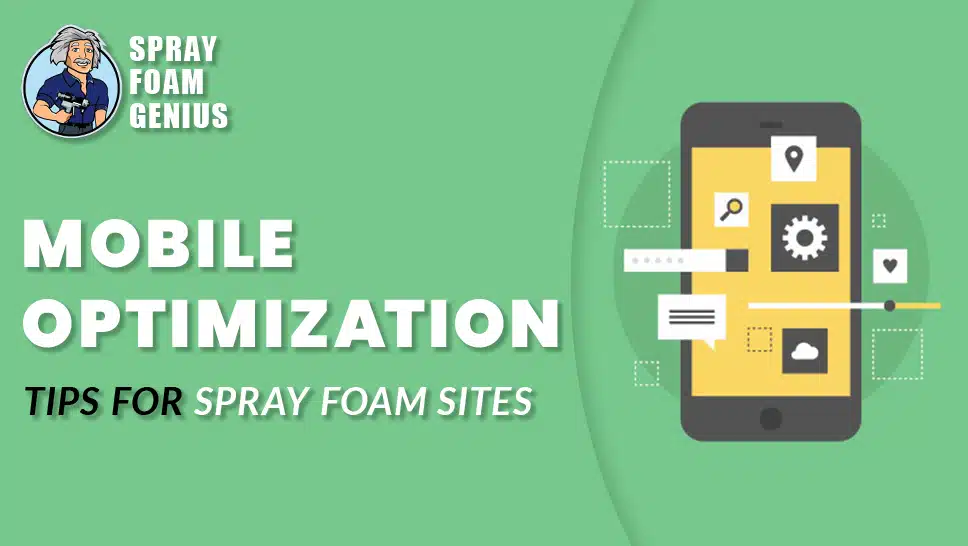
In today’s digital age, optimizing your website for mobile devices is more crucial than ever. With the increasing use of smartphones and tablets, ensuring your spray foam website provides a seamless experience on all devices can significantly impact your business’s success. At Spray Foam Genius Marketing, we understand the unique needs of spray foam insulation contractors and are here to help you navigate the complexities of mobile optimization. In this guide, we’ll walk you through essential strategies to optimize your spray foam website for mobile, helping you attract and retain more clients.
The Importance of Mobile Optimization

The Shift to Mobile
The shift toward mobile browsing is undeniable. Statista reports that over 54% of global web traffic now comes from mobile devices. This shift is especially relevant for spray foam contractors, as many potential clients will search for services on their smartphones while on the go.
Benefits of a Mobile-Friendly Website
Having a mobile-optimized website offers several advantages:
- Improved User Experience: A site that functions well on mobile devices provides a better user experience, keeping visitors engaged and reducing bounce rates.
- Enhanced Visibility in Search Engines: Google prioritizes mobile-friendly websites in its search rankings, meaning your site is more likely to appear in search results when optimized for mobile.
- Increased Conversion Rates: A seamless mobile experience can lead to higher conversion rates as users are more likely to contact you or request a quote.
Key Strategies for Mobile Optimization
1. Adopt Responsive Web Design
What is Responsive Web Design?
Responsive web design ensures that your website adapts to various screen sizes and orientations. It provides a consistent and optimal viewing experience across all devices.
How to Implement Responsive Design
- Fluid Grids: Use a fluid grid layout that scales your content proportionally. This ensures that your website adjusts to different screen sizes without losing functionality or aesthetics.
- Flexible Images: Implement responsive images that resize automatically to fit different screens. This prevents images from being too large or too small on mobile devices.
- Media Queries: Utilize CSS media queries to apply different styles based on the device’s screen size. This allows you to tailor the design and layout for mobile users.
2. Simplify Mobile Navigation
Why Navigation Matters
Effective navigation is crucial for a positive mobile experience. On smaller screens, users need to find information quickly and easily.
Tips for Mobile-Friendly Navigation
- Use a Mobile Menu: Incorporate a hamburger menu or a collapsible menu to save space and keep your site organized.
- Prioritize Key Elements: Ensure that essential information, such as contact details, service descriptions, and call-to-action buttons, are easily accessible.
- Touch-Friendly Buttons: Design buttons and links that are large enough for users to tap comfortably, reducing the risk of misclicks.
3. Optimize Page Speed
The Importance of Page Speed
Page speed affects user experience and search engine rankings. Slow-loading pages can frustrate users and lead to higher bounce rates.
How to Improve Page Speed
- Compress Images: Use image optimization tools to reduce file sizes without sacrificing quality. Smaller images load faster and improve page performance.
- Minimize HTTP Requests: Limit the number of elements on your page to decrease the number of HTTP requests. This includes combining files and removing unnecessary scripts.
- Leverage Browser Caching: Enable browser caching to store static resources locally on users’ devices. This speeds up loading times for returning visitors.
- Utilize a Content Delivery Network (CDN): A CDN can help distribute your website’s content across multiple servers worldwide, reducing load times and improving performance.
4. Optimize Content for Mobile Users
Crafting Mobile-Friendly Content
Content should be easy to read and interact with on mobile devices. Mobile users often skim content, so it’s essential to present information clearly and concisely.
Content Optimization Tips
- Use Short Paragraphs: Break content into short, digestible paragraphs to enhance readability on small screens.
- Employ Bullet Points: Use bullet points or numbered lists to highlight key information and make it easier for users to scan.
- Choose Legible Fonts: Select fonts that are easy to read on small screens and ensure they are appropriately sized for mobile viewing.
- Prioritize Important Information: Place critical details, such as contact information and key services, at the top of the page where they are most visible.
5. Focus on Local SEO
The Role of Local SEO
Many mobile searches have local intent, meaning users are looking for services near them. Optimizing for local SEO can help attract nearby clients.
Local SEO Strategies
- Optimize Your Google Business Profile: Claim and optimize your Google Business Profile with accurate contact details, business hours, and location information.
- Incorporate Local Keywords: Use keywords related to your location and services in your content to improve your visibility in local search results.
- Encourage Customer Reviews: Positive reviews can enhance your credibility and improve your rankings in local search results. Encourage satisfied clients to leave reviews on Google and other review platforms.
6. Test and Analyze Mobile Performance
Continuous Improvement
Regular testing and analysis are vital for maintaining a mobile-friendly website. Use tools to evaluate your site’s performance and identify areas for improvement.
Key Metrics to Monitor
- Load Time: Track how quickly your site loads on mobile devices. Aim for a load time of three seconds or less.
- Bounce Rate: Monitor the percentage of visitors who leave your site after viewing only one page. A high bounce rate may indicate issues with mobile usability.
- Conversion Rate: Measure how effectively your site converts mobile visitors into leads or clients. Monitor form submissions, calls, and other key actions.
Stop Wasting Money on Ineffective Ads – Talk to Us!
Optimizing your spray foam website for mobile devices is essential for providing a positive user experience and staying competitive in today’s digital marketplace. By adopting responsive design, simplifying navigation, improving page speed, optimizing content, focusing on local SEO, and continuously testing performance, you can ensure your website meets the needs of mobile users and drives business growth.
At Spray Foam Genius Marketing, we specialize in helping spray foam insulation contractors enhance their online presence. If you need assistance with mobile optimization or any other aspect of your digital marketing strategy, we’re here to help.
Call us at 877-840-FOAM for USA and 844-741-FOAM for Canada visit our website at sprayfoamgeniusmarketing.com, or email us at [email protected].
Let’s work together to elevate your digital presence and attract more clients!
- Social Media Marketing for Spray Foam Businesses: What Works in 2025? - February 6, 2025
- Best SEO Strategies for Spray Foam Insulation Contractors to Rank #1 on Google - February 6, 2025
- What is Spray Foam Insulation? Benefits and Applications - February 5, 2025

